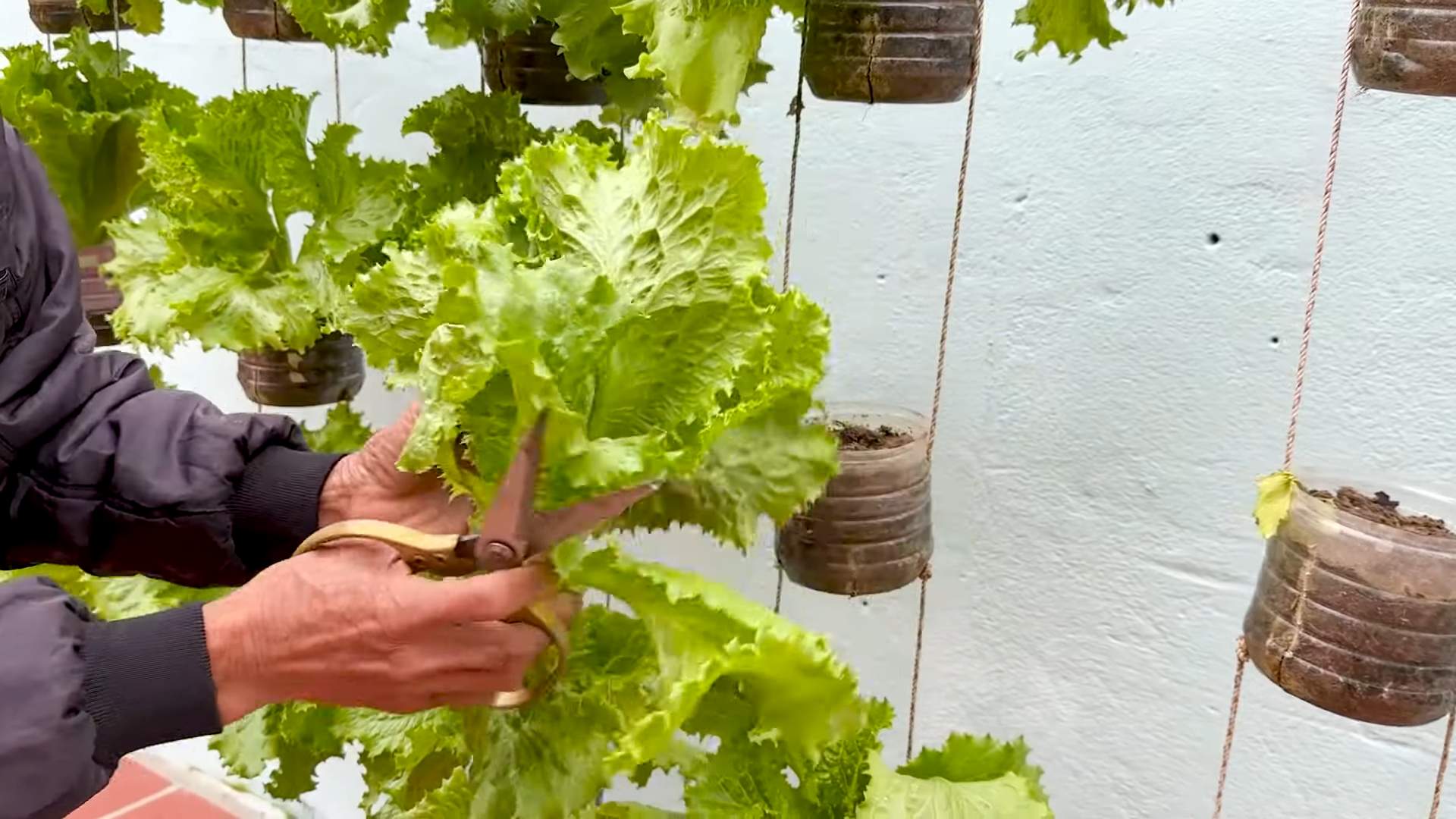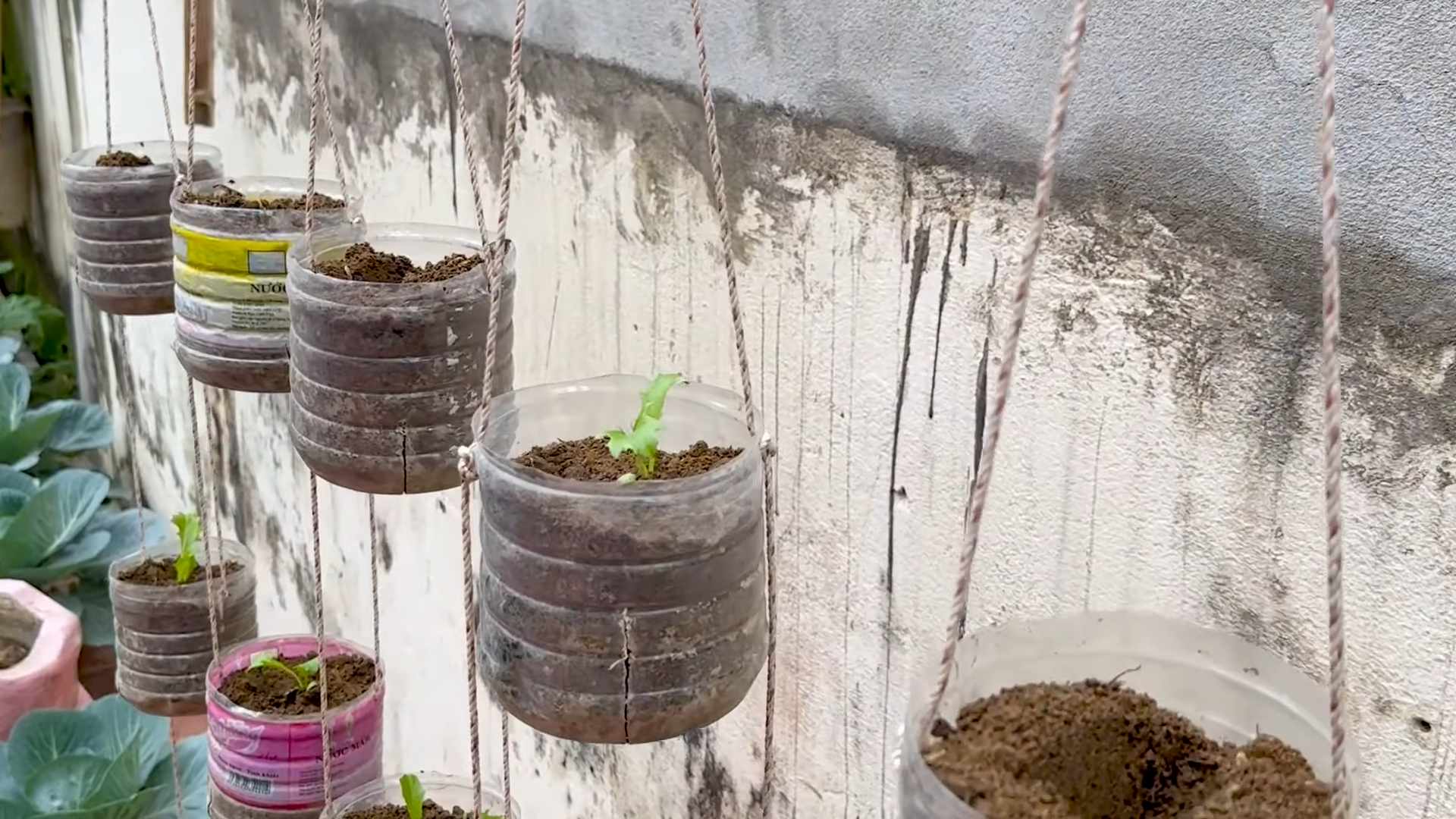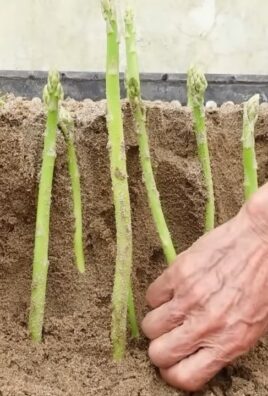Easy Home Lettuce Growing – sounds like a dream, right? Imagine stepping outside your back door and snipping fresh, crisp lettuce for your salad, sandwich, or even a quick snack. No more trips to the grocery store for wilted, overpriced greens! This isn’t just a dream; it’s an achievable reality with a few simple tricks and DIY hacks.
Lettuce has a rich history, dating back to ancient Egypt, where it was initially cultivated for its seeds and oil. Over time, the leafy greens we know and love became a staple in diets worldwide. But why rely on commercial farming when you can bring this ancient tradition right to your own backyard (or even your windowsill)?
In today’s world, we’re all looking for ways to eat healthier, save money, and connect with nature. Easy Home Lettuce Growing addresses all these needs! I’m going to share some simple, effective methods that will have you harvesting your own delicious lettuce in no time. Whether you’re a seasoned gardener or a complete beginner, these DIY tips will empower you to create a thriving lettuce patch with minimal effort and maximum reward. Get ready to ditch the store-bought lettuce and embrace the joy of growing your own!

Grow Your Own Lettuce: A Beginner-Friendly DIY Guide
Hey there, fellow gardening enthusiasts! Ever dreamt of snipping fresh, crisp lettuce leaves right from your own backyard (or even your windowsill!) for your salads? Well, dream no more! Growing your own lettuce is surprisingly easy, rewarding, and a whole lot cheaper than buying it at the grocery store. Plus, you know exactly what’s going into your food – no mystery pesticides here! I’m going to walk you through everything you need to know to get started, from choosing the right lettuce variety to harvesting your bounty. Let’s get our hands dirty!
Choosing Your Lettuce Variety
First things first, let’s talk lettuce types. There’s a whole world of lettuce out there, and choosing the right one can make all the difference. Here’s a quick rundown of some popular options:
* **Loose-leaf Lettuce:** This is probably the easiest type to grow, and it’s perfect for beginners. You can harvest leaves as you need them, and the plant will keep producing. Think varieties like ‘Black Seeded Simpson’, ‘Red Sails’, and ‘Oak Leaf’.
* **Butterhead Lettuce:** These lettuces form loose heads with soft, buttery leaves. ‘Buttercrunch’ and ‘Bibb’ are classic choices. They’re a bit more delicate than loose-leaf, but still relatively easy to grow.
* **Romaine Lettuce:** Known for its upright growth and crisp leaves, romaine is a staple for Caesar salads. ‘Paris Island Cos’ and ‘Dark Green Romaine’ are popular varieties.
* **Crisphead Lettuce:** This is your classic iceberg lettuce. While it’s the most challenging to grow, it’s not impossible! ‘Great Lakes’ is a common variety.
For beginners, I highly recommend starting with loose-leaf or butterhead lettuce. They’re more forgiving and quicker to mature.
Gathering Your Supplies
Okay, now that we’ve picked our lettuce, let’s gather our supplies. You won’t need much, which is part of what makes this project so great!
* **Lettuce Seeds:** Obviously! Choose the variety you want to grow.
* **Potting Soil:** Use a good quality potting mix, not garden soil. Potting mix is lighter and drains better, which is crucial for lettuce.
* **Containers (Optional):** If you’re growing in containers, you’ll need pots or containers with drainage holes. Even old yogurt containers with holes poked in the bottom will work in a pinch!
* **Watering Can or Hose:** For watering your lettuce.
* **Fertilizer (Optional):** A balanced liquid fertilizer can help your lettuce grow faster, but it’s not essential.
* **Grow Lights (Optional):** If you’re growing indoors and don’t have a sunny spot, you might need grow lights.
Planting Your Lettuce Seeds
Now for the fun part – planting! You can start your lettuce seeds indoors or directly sow them in your garden, depending on your climate and the time of year.
Starting Seeds Indoors (Recommended for Early Starts)
Starting seeds indoors gives you a head start on the growing season, especially if you live in a colder climate.
1. **Prepare Your Seed Starting Tray or Pots:** Fill your seed starting tray or small pots with potting mix. Moisten the soil gently.
2. **Sow the Seeds:** Sprinkle a few lettuce seeds on top of the soil in each cell or pot. Lettuce seeds are tiny, so don’t bury them too deep. A light dusting of soil is all they need.
3. Gently Water: Use a spray bottle to mist the soil. You don’t want to dislodge the seeds.
4. **Provide Light:** Place the tray or pots in a sunny window or under grow lights. Lettuce needs plenty of light to germinate.
5. **Keep the Soil Moist:** Keep the soil consistently moist, but not soggy.
6. **Thin Seedlings (If Necessary):** Once the seedlings emerge (usually in about a week), thin them out so that only one strong seedling remains in each cell or pot.
7. **Harden Off Seedlings:** Before transplanting your seedlings outdoors, you need to “harden them off.” This means gradually exposing them to outdoor conditions over a period of a week or so. Start by placing them outside for an hour or two each day, gradually increasing the time.
Direct Sowing Seeds Outdoors
If the weather is warm enough, you can sow your lettuce seeds directly in your garden.
1. **Prepare the Soil:** Choose a spot in your garden that gets at least 6 hours of sunlight per day. Loosen the soil and remove any rocks or debris. Amend the soil with compost or other organic matter if needed.
2. **Create Shallow Rows:** Make shallow rows in the soil, about 1/4 inch deep.
3. **Sow the Seeds:** Sprinkle the lettuce seeds in the rows, spacing them about an inch apart.
4. Cover the Seeds: Gently cover the seeds with a thin layer of soil.
5. **Water Gently:** Water the soil gently, being careful not to wash away the seeds.
6. **Thin Seedlings:** Once the seedlings emerge, thin them out so that they are spaced about 6-8 inches apart.
Caring for Your Lettuce Plants
Once your lettuce plants are established, it’s time to give them some TLC.
1. **Watering:** Lettuce needs consistent moisture, especially during hot weather. Water deeply whenever the top inch of soil feels dry. Avoid overhead watering, as this can lead to fungal diseases.
2. **Fertilizing (Optional):** If you want to give your lettuce a boost, you can fertilize it with a balanced liquid fertilizer every few weeks. Follow the instructions on the fertilizer label.
3. **Weeding:** Keep the area around your lettuce plants free of weeds. Weeds compete with lettuce for water and nutrients.
4. **Pest Control:** Lettuce is relatively pest-resistant, but you may encounter aphids or slugs. You can control aphids with insecticidal soap or by handpicking them off the plants. Slugs can be controlled with slug bait or by handpicking them at night.
5. **Sunlight:** Lettuce needs at least 6 hours of sunlight per day. If you’re growing lettuce indoors, you may need to supplement with grow lights.
6. Bolting Prevention: Bolting is when lettuce plants send up a flower stalk and the leaves become bitter. This usually happens in hot weather. To prevent bolting, choose heat-resistant varieties, provide shade during the hottest part of the day, and water regularly.
Harvesting Your Lettuce
The best part! You can start harvesting lettuce leaves as soon as they are big enough to eat.
1. **Harvesting Loose-Leaf Lettuce:** For loose-leaf lettuce, you can harvest individual leaves as you need them. Simply snip off the outer leaves with scissors or a knife, leaving the inner leaves to continue growing.
2. **Harvesting Head Lettuce:** For head lettuce, wait until the head is firm and well-formed. Cut the head off at the base of the plant with a sharp knife.
3. **Harvesting Time:** Harvest lettuce in the morning, when the leaves are crisp and cool.
4. **Washing and Storing:** Wash the lettuce leaves thoroughly and store them in a plastic bag in the refrigerator. Lettuce will keep for several days.
Troubleshooting
Even with the best care, you might encounter some problems while growing lettuce. Here are a few common issues and how to deal with them:
* **Lettuce is Bolting:** As mentioned earlier, bolting is when lettuce plants send up a flower stalk and the leaves become bitter. To prevent bolting, choose heat-resistant varieties, provide shade during the hottest part of the day, and water regularly. If your lettuce does bolt, you can still harvest the leaves, but they won’t taste as good.
* **Lettuce Leaves are Turning Yellow:** Yellowing leaves can be a sign of overwatering, underwatering, or nutrient deficiency. Check the soil moisture and adjust your watering accordingly. If the soil is consistently moist, you may be overwatering. If the soil is dry, you may be underwatering. You can also try fertilizing your lettuce with a balanced liquid fertilizer.
* **Lettuce Leaves are Being Eaten:** If your lettuce leaves are being eaten, you may have a pest problem. Check the plants for aphids, slugs, or other pests. Control pests with insecticidal soap, slug bait, or by handpicking them off the plants.
* **Lettuce Seeds Aren’t Germinating:** If your lettuce seeds aren’t germinating, make sure the soil is moist and the seeds are getting enough light. Lettuce seeds need light to germinate, so don’t bury them too deep.
Extending Your Lettuce Season
Want to enjoy fresh lettuce all season long? Here are a few tips for extending your lettuce season:
* **Succession Planting:** Plant new lettuce seeds every few weeks to ensure a continuous harvest.
* **Choose Heat-Resistant Varieties:** As mentioned earlier, choose heat-resistant varieties to prevent bolting

Conclusion
So, there you have it! Growing your own lettuce at home is not only achievable, but it’s also incredibly rewarding. Forget those limp, pre-packaged greens from the supermarket. With this simple DIY trick, you can have crisp, fresh, and flavorful lettuce right at your fingertips, ready to elevate your salads, sandwiches, and wraps.
Why is this a must-try? Because it puts you in control. You know exactly what’s going into your lettuce – no pesticides, no preservatives, just pure, unadulterated goodness. Plus, the taste difference is undeniable. Homegrown lettuce boasts a vibrant flavor that store-bought varieties simply can’t match. And let’s not forget the cost savings! Over time, you’ll significantly reduce your grocery bill by growing your own supply.
But the benefits extend beyond taste and savings. Gardening, even on a small scale, is a fantastic stress reliever. There’s something incredibly therapeutic about nurturing a plant from seed to harvest. It’s a connection to nature that can bring a sense of calm and accomplishment to your day.
Ready to take your lettuce game to the next level? Consider these variations:
* Experiment with different lettuce varieties: Romaine, butterhead, loose-leaf – the possibilities are endless! Each variety offers a unique flavor and texture, so find your favorites.
* Try succession planting: Plant new seeds every few weeks to ensure a continuous harvest throughout the growing season. This way, you’ll always have fresh lettuce on hand.
* Get creative with containers: While we’ve focused on a simple container setup, feel free to explore other options like raised beds, vertical gardens, or even repurposed items like old tires or pallets.
* Add companion plants: Basil, chives, and garlic are excellent companions for lettuce, helping to deter pests and improve growth.
Ultimately, the best way to discover the joys of homegrown lettuce is to simply give it a try. Don’t be intimidated if you’re a beginner. This DIY trick is designed to be easy and accessible for everyone. Start small, be patient, and enjoy the process.
We’re confident that once you taste the difference of homegrown lettuce, you’ll never go back to store-bought again. So, grab your supplies, get your hands dirty, and start growing!
We’d love to hear about your experience! Share your photos, tips, and questions in the comments below. Let’s create a community of home gardeners and inspire others to embrace the joys of growing their own food. Happy gardening!
Frequently Asked Questions (FAQ)
What kind of soil is best for growing lettuce?
Lettuce thrives in well-draining, fertile soil that is rich in organic matter. A good quality potting mix specifically formulated for vegetables is an excellent choice for container gardening. You can also amend your existing soil with compost or aged manure to improve its fertility and drainage. Avoid heavy clay soils, as they can become waterlogged and hinder lettuce growth. The ideal soil pH for lettuce is between 6.0 and 7.0.
How much sunlight does lettuce need?
Lettuce prefers partial shade, especially during the hottest part of the day. While it needs sunlight to grow, too much direct sun can cause the leaves to wilt and become bitter. Aim for at least 4-6 hours of sunlight per day, ideally in the morning or late afternoon. If you live in a particularly hot climate, consider providing some shade during the peak sun hours.
How often should I water my lettuce?
Lettuce needs consistent moisture to thrive, but avoid overwatering, which can lead to root rot. Water deeply whenever the top inch of soil feels dry to the touch. Check the soil moisture regularly, especially during hot or dry weather. Water in the morning to allow the leaves to dry before nightfall, which can help prevent fungal diseases.
How do I know when my lettuce is ready to harvest?
Lettuce is typically ready to harvest when the leaves are large enough to eat, usually around 4-6 inches long. You can harvest the entire head at once, or you can harvest individual leaves as needed, starting with the outer leaves. This “cut-and-come-again” method allows you to enjoy a continuous harvest over a longer period.
What are some common pests and diseases that affect lettuce?
Common pests that can affect lettuce include aphids, slugs, snails, and cutworms. You can control these pests with organic methods such as handpicking, using insecticidal soap, or applying diatomaceous earth. Common diseases include downy mildew, powdery mildew, and bottom rot. Prevent these diseases by providing good air circulation, avoiding overwatering, and removing any infected leaves promptly.
Can I grow lettuce indoors?
Yes, you can absolutely grow lettuce indoors, especially during the colder months. Provide your lettuce with plenty of light, either from a sunny window or a grow light. Use a well-draining potting mix and water regularly. Indoor lettuce may not grow as quickly as outdoor lettuce, but it’s a great way to enjoy fresh greens year-round.
How do I prevent my lettuce from bolting (going to seed)?
Bolting is when lettuce plants prematurely produce a flower stalk and become bitter. This is often triggered by hot weather or stress. To prevent bolting, choose heat-tolerant lettuce varieties, provide shade during the hottest part of the day, and water regularly. Harvesting leaves regularly can also help delay bolting.
Can I grow lettuce from seed or do I need to buy seedlings?
You can grow lettuce from either seed or seedlings. Starting from seed is more economical, but it requires a bit more patience. Seedlings are a good option if you want a quicker harvest. When starting from seed, sow the seeds directly into the container or start them indoors a few weeks before transplanting.
What are some good companion plants for lettuce?
Lettuce benefits from being planted near certain other plants. Good companion plants for lettuce include:
* Carrots: Carrots help to loosen the soil, making it easier for lettuce roots to grow.
* Radishes: Radishes deter pests that can attack lettuce.
* Garlic and Onions: These plants repel aphids and other insects.
* Marigolds: Marigolds attract beneficial insects that prey on lettuce pests.
* Herbs (Basil, Mint, Chives): Many herbs deter pests and improve the flavor of lettuce.
How do I store harvested lettuce?
To store harvested lettuce, wash it thoroughly and dry it completely. Wrap the lettuce in a paper towel and place it in a plastic bag or container in the refrigerator. This will help keep the lettuce crisp and fresh for up to a week. Avoid storing lettuce near fruits that produce ethylene gas, such as apples and bananas, as this can cause the lettuce to brown.




Leave a Comment